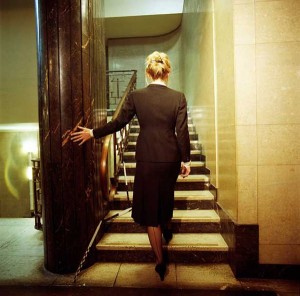
Jane and Louise Wilson, "Unfolding the Aryan Papers" (still), 2009
In a big, sprawling, multi-tentacular artsfest like the Edinburgh Festival, certain forms of art – like, say, one-woman mime interpretations of the career of Robin Williams, or freestyle macrame workshops – tend to get drowned out under the clamor of what has become an almost entirely comedy-centric festival, bankrolled by cigar-chomping commercial behemoths. “A sell-out” is standard festival-speak for “a success,” but it’s all too eloquent of what the festival appears to have become. The Edinburgh Art Festival runs concurrently with the comedy and theater festivals, and this year has chosen to withdraw into an erudite, multifarious and thoughtful analysis of the city’s intellectual past and present. And while its refusal to participate in the barking rhetoric of its (let’s face it) less economically stable artistic cousins looks passive-aggressive, even truculent, it’s resulted in one of the most engaging and coherent Art Festivals in years.
While no homogenous curatorial scheme unites the Edinburgh Art Festival, there is a loose theme of “Enlightenment” shared by large-scale theatrical and musical events in the International Festival. Spread out across a number of venues, The Enlightenments (curated by Australian Juliana Engberg) explores the legacy of the intellectual climate of 18th-century Scotland, immortalized in the thickets of classical columns and gridded streets throughout the city. In the Dean Gallery (perhaps best-known for its extraordinary collection of European Surrealism and British Pop), Engberg has installed a loose-synapsed roam through recent explorations of empiricism. Joshua Mosley’s dread, his short animated film of Pascal and Rousseau anachronistically bumping into each other in a forest, and Tacita Dean’s Presentation Sisters, her muzzy, autumnal film of Irish nuns pottering about in their convent, may only have passing relevance to Engberg’s theme (and each other), but as investigations of the nature of faith in a relentlessly empirical world, they strike a resonant blow for mystery. And underneath Eduardo Paolozzi’s massive steel Vulcan, four singers and a ukelele, as part of Gabrielle de Vietri’s performance Hark!, perform that day’s international news as a kind of tribute to pre-modern means of information. Their song about the (then impending) release of Abdelbaset Ali al-Megrahi provided one of those neck-hair-elevations you can forget are possible in contemporary art.
Meanwhile, in the Talbot Rice Gallery in the heart of the University’s Old College, Jane and Louise Wilson’s Unfolding The Aryan Papers is the sisters’ richest work to date. The film, shown on a huge screen between two mirrored panels, centers around Dutch actress Johanna ter Steege, the heroine of Stanley Kubrick’s cancelled project The Aryan Papers, his aborted attempt at tackling the Holocaust on film. The Wilsons intersperse, with hypnotic elegance and poise, the director’s own obsessive headshots of the actress (mouth open, mouth closed, in various dresses), the actress’s own recreations of the early stages of character development, and stills of Kubrick’s location shoots, his calibated yardstick (cast as bronze copies in another room) propped in each shot like a signature. On one level, the film is an examination of the notion of the female subject battling to be heard above the steamrolling male creative ego, but it slips its own polemic shackles by quietly asserting its own casual beauty, hovering on a small constellation of buttons on a sleeve with a kind of defiance.
Turner Prize nominee Lucy Skaer continues her collaboration with filmmaker Rosalind Nashashibi in their new film, Our Magnolia, at the marvelous doggerfisher gallery on the other side of the city. In a similar spirit to the Wilson sisters’ magpie bricolage, the artists have threaded found and original footage together in a sort of tribute to the double image. Bookended by unsteady shots of British Surrealist Paul Nash’s Flight of the Magnolia (1944), the film flits between images of the desecrated Museum of Baghdad, a rotting dog’s corpse on a beach, and headshots of Margaret Thatcher, sunblanched on an office table. In both films, beauty appears like a surprise, captured unaware. And while I spent most of the train journey back trying to remember the best jokes I’d heard (something about chimps, something about milk), what stayed were those still, intense, commanding images from Dean and the Wilsons’ films, which were great for this post, but not so good for my social life. But, you know…



